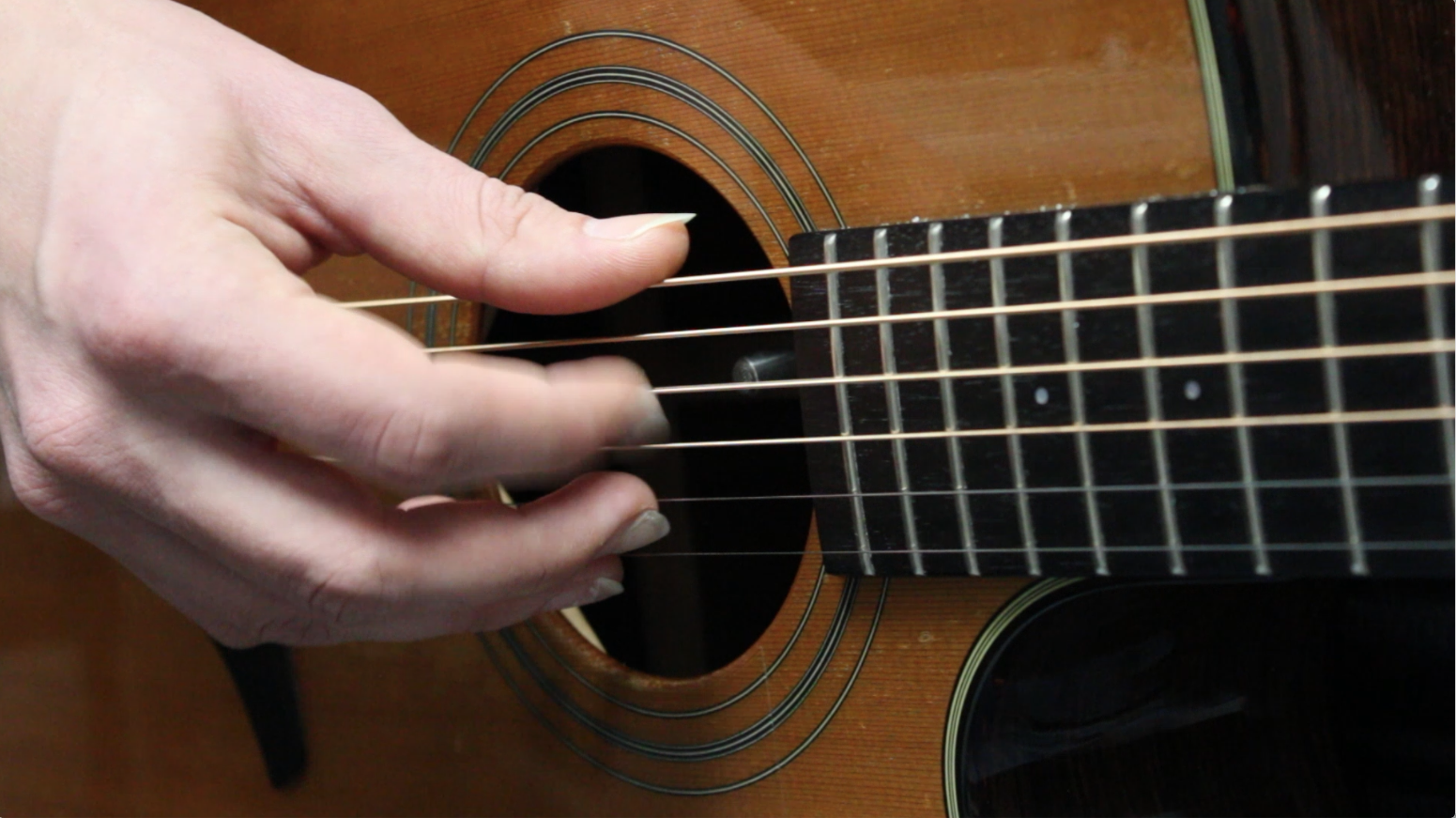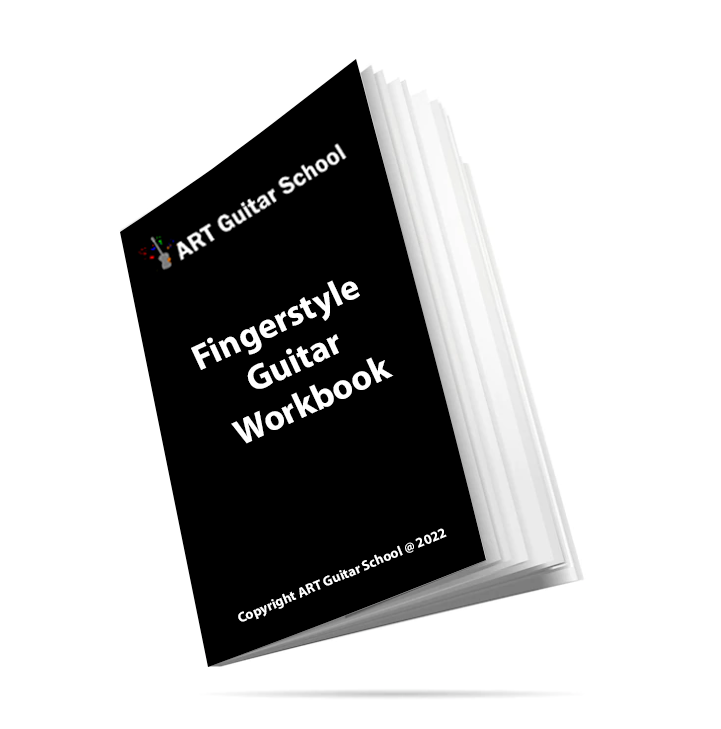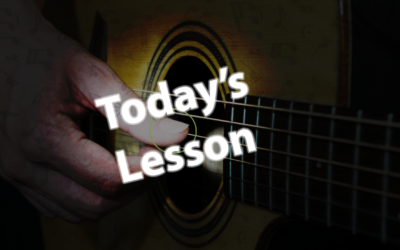FINGERPICKING KEY

The right hand:
P = Thumb
I = Index
M = Middle
A = Ring
Fingerpicking Pattern No. 1
This is the most essential fingerpicking pattern to start with. It requires no left hand chord or fretted notes. It is used in many popular fingerpicking songs and some songs are slight variations of this same pattern.
We have all open strings being plucked in sequential order. Each note is a quarter note in duration and will last exactly one second each if played at 60bpm.
Lets get to playing!
We will pluck each open string in order starting from the 6th string (Low E) and ending on the 1st (High E).
Step 1. Lets start with thumb (p) and pluck the 6th-4th string
Step 2. Pluck index (i), middle (m) and ring (a) on the 3rd-1st strings.

Here is a video demonstration of the finger picking pattern:
If you were having trouble please contact us and we will help you!
FOLLOW US ON
Get our FREE Fingerstyle Workbook!
RELATED BLOG POSTS
Creating Beautiful Melodies with Fingerstyle Guitar
Fingerstyle guitar is one of the most expressive ways to create beautiful, intricate melodies on the instrument. By using both hands simultaneously to play melody, harmony, and rhythm, you can transform a simple chord progression into a rich, dynamic musical piece. In this post, we’ll explore the techniques and approaches that can help you create stunning melodies using fingerstyle guitar.
1. Focus on Melody and Harmony Simultaneously
One of the most powerful aspects of fingerstyle guitar is the ability to play melody and harmony at the same time. While your thumb plays the bass notes, your fingers can pluck higher strings to create the melody. The key to creating beautiful melodies is not just about finding the right notes but also about shaping those notes with dynamics and timing.
When creating a melody, think of it like singing. Pay attention to the phrasing, dynamics, and the space between the notes. Don’t rush through the melody—let each note resonate and breathe. A well-timed pause or a subtle dynamic shift can make a simple melody sound more captivating.
2. Experiment with Fingerpicking Patterns
Fingerpicking patterns are essential in fingerstyle guitar, providing both the rhythmic foundation and the opportunity to express melody. By experimenting with various picking patterns, you can give your melody a unique flavor. Try alternating between more straightforward patterns, like Travis picking, and more intricate arpeggios, where the fingers play different strings in quick succession.
Fingerpicking patterns can provide a delicate, flowing backdrop for the melody while keeping the rhythm moving. Adjusting the rhythm and adding syncopation or off-beat accents can also make the melody more interesting and expressive.
3. Use Open Strings to Enhance the Sound
Open strings can bring a sense of resonance and harmony to your melodies. These strings can create harmonic overtones that enhance the depth and richness of your playing. By incorporating open strings into your fingerstyle pieces, you create a fuller sound with less effort, allowing for smoother transitions between chords and melodies.
You can use open strings in various ways, such as incorporating them in arpeggios or letting them ring out as part of a chord. Open strings often lend a more “natural” or “organic” quality to the music, making the melody sound more effortless and flowing.
4. Incorporate Hammer-Ons and Pull-Offs
Hammer-ons and pull-offs are valuable techniques for creating fluid and legato melodies. These techniques allow you to connect notes smoothly without having to pick each one individually. By using hammer-ons and pull-offs, you can add a sense of grace and ease to your melodies, making them sound more like a vocal line or even a string instrument.
Using these techniques sparingly in the right moments adds subtlety and sophistication to your melody. The smooth connection between the notes creates a more seamless, flowing sound, enhancing the overall beauty of your piece.
5. Play with Dynamics and Expression
In fingerstyle guitar, dynamics play a critical role in bringing your melodies to life. Experiment with playing some notes softly and others loudly to create contrast and emotional depth. By adjusting the pressure you apply with your fingers and thumb, you can control the volume and articulation of each note.
The key is to think of your fingers as an expressive tool. Just like a vocalist can emphasize certain syllables or a pianist can strike the keys with more force for dramatic effect, your fingers can deliver subtle or powerful expressions on the guitar. A quiet passage can convey tenderness, while a louder, more forceful section can add intensity.
6. Use Chord Voicings that Complement the Melody
Chord voicings are the different ways you can play the same chord by using different finger placements on the fretboard. When crafting a melody, the way you voice your chords can have a huge impact on the overall sound. By choosing chord voicings that complement your melody, you can make the entire piece sound more cohesive and harmonious.
Instead of simply playing basic open-position chords, explore inversions or barre chords that allow you to emphasize different bass notes or create smoother voice-leading between chords. Using alternative chord voicings will allow your melodies to shine through more clearly, while adding depth and color to the harmonies.
7. Practice Improvisation to Find New Ideas
One of the best ways to create beautiful melodies is to improvise regularly. Improvisation helps you break free from rigid structures and discover new ways of playing melodies. When improvising, don’t worry about hitting the “perfect” notes. Focus on experimenting with phrasing, rhythm, and dynamics.
Try improvising over simple chord progressions or backing tracks, allowing your fingers to explore different intervals and melodic shapes. The more you improvise, the more you’ll unlock new musical ideas and be able to incorporate them into your fingerstyle pieces.
8. Pay Attention to Phrasing
Phrasing is crucial when crafting memorable melodies. Just like in vocal music, guitar melodies need to be phrased thoughtfully. Think about how you would sing a line of a song and apply that same concept to your playing. Allow certain notes to linger, pause, or resolve in ways that make the melody feel natural and connected.
A good way to practice phrasing is by playing simple melodies and experimenting with different rhythmic placements and note durations. Try to create a sense of “beginning” and “end” within your phrases, and allow each phrase to have its own musical “story.”
9. Add Ornamentation
Ornamentation is when you add small, decorative notes to your melody to make it more intricate and interesting. Techniques such as slides, grace notes, or vibrato can add an extra layer of expression to your playing.
While ornamentation should not overpower the main melody, it can be a great way to add color and complexity. By experimenting with various ornaments, you can add subtle nuances to your playing and make the melody feel more expressive and dynamic.
10. Create Contrast with Rhythmic Variations
Variety is essential in keeping a melody engaging. To create contrast and interest, experiment with different rhythmic patterns. Instead of playing the same rhythm throughout the piece, vary it by using syncopated or off-beat rhythms. This adds excitement and keeps the melody from becoming predictable.
Playing with rhythm can also involve changing up the feel of the song, such as switching from a smooth legato feel to a more percussive, staccato rhythm. These variations can keep the listener’s attention and make the melody more dynamic.
Conclusion
Creating beautiful melodies on fingerstyle guitar is about more than just playing the right notes. It’s about shaping those notes with dynamics, phrasing, and expression. By experimenting with fingerpicking patterns, chord voicings, improvisation, and rhythmic variation, you can craft melodies that are both beautiful and captivating. Focus on the emotional impact of your playing, and remember that even a simple melody can sound stunning with the right technique and musicality.
How to Read Fingerstyle Guitar Tablature
Reading guitar tablature (or “tabs”) is an essential skill for any guitarist, especially for those focusing on fingerstyle playing. While standard sheet music can be daunting for beginners, tablature is a simplified notation system that shows you exactly where to place your fingers on the fretboard. If you’re new to fingerstyle guitar, understanding how to read fingerstyle tabs will greatly speed up your learning process.
In this post, we’ll explain how to read fingerstyle guitar tablature and highlight some of the unique symbols you’ll encounter when playing fingerstyle pieces.
1. Basic Guitar Tablature
Guitar tabs consist of six horizontal lines that represent the six strings of the guitar. The bottom line corresponds to the low E string (the thickest string), and the top line corresponds to the high E string (the thinnest string). Numbers are placed on these lines to show you which fret to press down.
In this simple example, you would play the following:
Open high E string (0 on the e line)
1st fret on the B string
2nd fret on the G string
3rd fret on the D string
4th fret on the A string
5th fret on the low E string
2. Fingerpicking Notation
In fingerstyle guitar, tabs often include additional information about which fingers should be used to pluck each string. Commonly, the thumb (T), index (I), middle (M), and ring (A) are used to notate which fingers should pluck the bass and melody notes.
For example, you might see a tab like this for fingerstyle:
The thumb (T) plays the bass note (the 6th string).
The index (I) plays the 2nd string.
The middle (M) plays the 3rd string.
The ring (A) plays the 4th string (but here, it’s silent).
3. Slashes and Hammers/Pulls
Fingerstyle tabs often use special symbols to indicate techniques such as hammer-ons (h), pull-offs (p), slides (/ or ), and more.
Hammer-On (h): A hammer-on is where you press a finger down onto a fretboard without picking the string again. For example:
The Art of Fingerstyle Guitar: Tips from the Pros
Fingerstyle guitar is not just a technique but an art form that combines melody, harmony, and rhythm all into one fluid performance. While many guitarists focus on learning the basic mechanics of fingerstyle, the true artistry comes from a combination of control, creativity, and expression. In this post, we’ll share some essential tips from professional fingerstyle guitarists that will help you elevate your playing to the next level.
1. Master the Basics Before Adding Complexity
While it may seem tempting to jump into advanced fingerstyle techniques, pros know that a solid foundation is key. Mastering basic patterns like Travis picking, alternating bass, and simple arpeggios will give you the control and accuracy you need to tackle more complex pieces. Once you have these basics under your fingers, you can start adding embellishments and experimenting with more intricate patterns.
“Mastery of the basics is the platform on which everything else rests. It’s the slow and steady work that counts the most.” — Tommy Emmanuel
2. Develop Finger Independence
One of the cornerstones of great fingerstyle playing is finger independence. Pro players can effortlessly move their thumb to play bass notes while their fingers handle melody or harmony. This independence is built through slow, deliberate practice. Try starting with simple bass lines using your thumb, while the rest of your fingers pick out melodies on higher strings. Over time, you’ll develop control over each finger, making more complex fingerpicking patterns much easier.
“Independent control of your thumb and fingers is a game-changer for fingerstyle guitarists. It’s about being able to do multiple things at once with precision.” — Andy McKee
3. Focus on Tone and Dynamics
Fingerstyle is all about nuance, and dynamics play a huge role in making a performance feel expressive. Professional guitarists emphasize varying the volume and intensity of each note to convey emotion. A soft, delicate touch can evoke a sense of intimacy, while a powerful stroke can add energy and excitement. Don’t just focus on speed or technicality—pay attention to the tone and dynamics of each note, and experiment with subtle changes in touch and pressure.
“Every note you play has to have a purpose. It’s about shaping the tone and making the guitar sing.” — Michael Hedges
4. Use Your Whole Hand
Many beginners focus only on their fingers when playing fingerstyle, but pros know that the entire hand—thumb, fingers, and even the palm—plays a role in achieving the best sound. The thumb controls the bass, but it’s also responsible for creating percussive sounds. Your fingers need to play delicately while ensuring the right balance between the bass and melody. Sometimes, your palm can even mute strings or create a rhythmic effect. Embrace the whole hand as an instrument.
“Your thumb is the backbone of fingerstyle. Your fingers are like the melody, and your palm is the secret weapon for controlling the sound.” — Per-Olov Kindgren
5. Embrace Fingerpicking Patterns
Fingerstyle guitar often relies on repeating patterns to create a smooth, flowing rhythm. Pros tend to gravitate toward certain iconic patterns, like Travis picking, but what truly sets their playing apart is how they personalize those patterns. A good exercise is to take a basic fingerpicking pattern, such as a simple arpeggio, and experiment by altering the rhythm or adding syncopation. The key is to make the pattern your own and inject it with your musical personality.
“Fingerpicking patterns should never feel robotic. Learn them, but then allow them to breathe and evolve as you play.” — John Gomm
6. Don’t Overcrowd the Song
In fingerstyle guitar, space is just as important as the notes you play. Pros know how to leave room in their playing, allowing the music to breathe and evolve naturally. Overplaying or cramming too many notes into a passage can make the performance feel cluttered. Instead, focus on creating a balance between melody, rhythm, and silence. Using space strategically will not only make your playing more musical but also enhance the emotional impact.
“Sometimes less is more. It’s not about cramming every idea you have into a song. Silence and space give the music room to grow.” — Andy Timmons
7. Experiment with Alternative Tunings
Many professional fingerstyle guitarists experiment with alternate tunings to unlock new harmonic possibilities and create fresh sounds. By tuning your guitar differently, you can access chords and melodies that are difficult or impossible to play in standard tuning. Some popular alternate tunings for fingerstyle include DADGAD, Open D, and Open G. Don’t be afraid to explore and experiment—alternate tunings can be a great way to inspire creativity and push your playing to new heights.
“Alternate tunings open up a whole new world on the guitar. They allow you to play with harmony in a way that standard tuning just doesn’t offer.” — Martin Simpson
8. Incorporate Percussive Elements
Percussion is a powerful tool in fingerstyle guitar, and top players know how to blend melody with rhythm seamlessly. Techniques like slap bass, body taps, and finger drumming can add a rhythmic, percussive dimension to your playing. These sounds are especially effective in live performances, where they add texture and engage the audience. You don’t need to overdo it, but incorporating subtle percussive elements can bring your playing to life.
“Percussion in fingerstyle can turn a quiet performance into something engaging. It’s like playing two instruments at once.” — Leo Kottke
9. Listen to Non-Guitarists for Inspiration
Professional fingerstyle players don’t just listen to other guitarists for inspiration—they broaden their horizons by drawing influence from all types of music. Whether it’s classical, jazz, or even world music, hearing how other musicians approach melody, harmony, and rhythm can help you develop a unique style. Classical pianists, drummers, and even vocalists often have great insight into phrasing and dynamics, which can be applied to guitar playing.
“Listen to music beyond the guitar world. It will shape your ideas and give you fresh perspectives on phrasing and tone.” — Antoine Dufour
10. Never Stop Experimenting
Finally, one of the key traits of professional fingerstyle guitarists is their constant drive to innovate. Whether it’s experimenting with different fingerpicking patterns, altering tunings, or incorporating new techniques, pros are always exploring and pushing the boundaries of what’s possible on the guitar. Never stop experimenting with your playing—it’s the only way to evolve as a musician and discover new possibilities.
“The key to great fingerstyle is experimentation. Never be afraid to try something new, even if it’s just a small change to your technique or approach.” — Don Ross
Conclusion
Fingerstyle guitar is an art form that combines technical skill with emotional expression. By incorporating these pro tips into your practice, you can take your fingerstyle playing to new heights. Focus on building a solid foundation, developing finger independence, and experimenting with new ideas. And most importantly, embrace the expressive nature of the instrument—let your guitar sing with your unique voice.




0 Comments